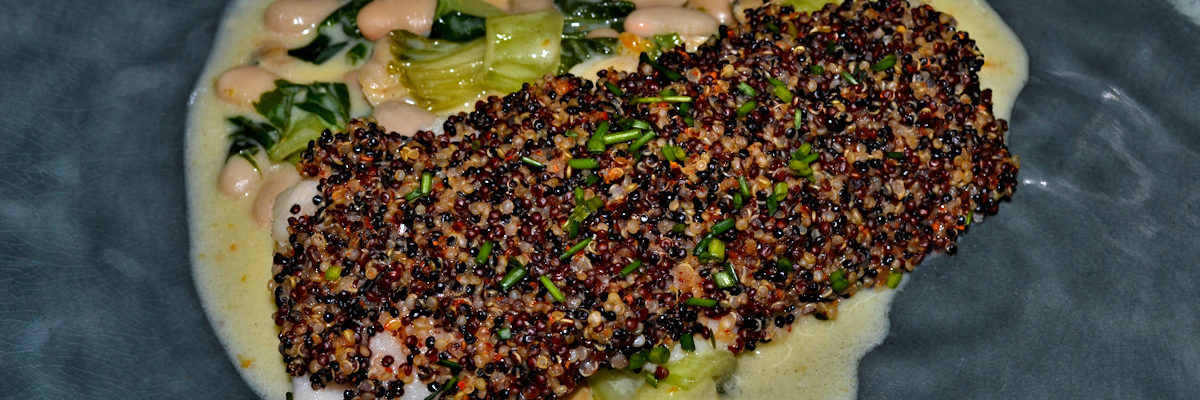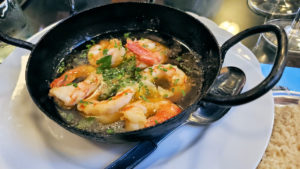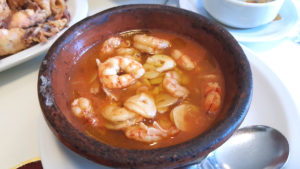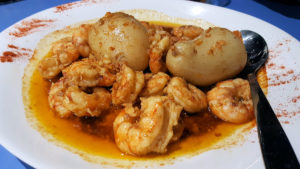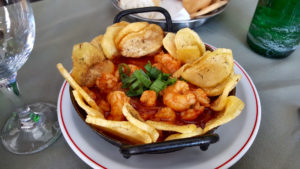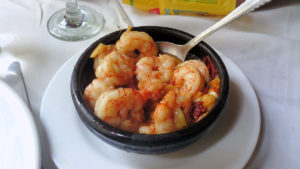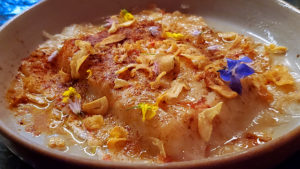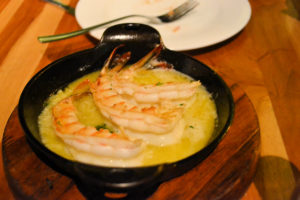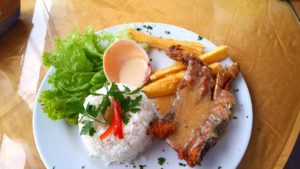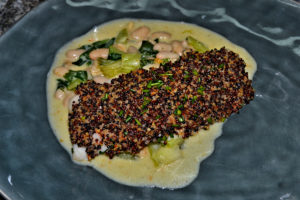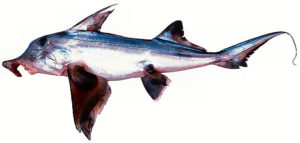Although I haven’t read any treatises attesting to the fact, I can make a reasonably educated guess that the near ubiquitous al ajillo preparation for prawns/shrimp, fish, and sometimes chicken throughout Latin America, originated in the Spanish colonization of those areas. There’s a classic Spanish dish, gambas al ajillo, that is usually served as a bubbling bowl of prawns in olive oil liberally flavored with sliced garlic and hot paprika, and often finished with lemon and/or parsley.
Mateos, Buenos Aires
Casa de Galicia, Buenos Aires
El Italiano, Montevideo
Centro Montañes, Buenos Aires
Taberna Baska, Buenos Aires
… Just to show some examples from various Spanish cuisine restaurants (and the last one a creative Argentine take) I’ve had the dish at in the last year or so.
But there are other takes… like this creative one with a carpaccio of prawns laid over toasted bread and covered with fried garlic, hot paprika, and drizzled with olive oil.
Mengano Bodegón
Or a Colombian version…
Central Cevicheria, Bogotá
Early on, I imagine that stocks of hot paprika ran out, and local versions in different countries began to pop up. A conquistador needs his comfort food, you know? In Mexico, it’s guajillo chilies, for example. In Peru, it’s generally ground aji panka – usually called aji rojo, and the garlic is usually chopped or grated into the sauce.
El Paisa, Trujillo
And, I thought that this week, we’d visit our Casa SaltShaker version, an amalgamation of the flavors from various versions tasted, with a touch of Nikkei, Japanese fusion, a touch of novo andino, and a bit of my own Mediterranean cooking background, bringing it sort of full circle.
Casa SaltShaker, Buenos Aires
First, the fish – any good meaty white fish will do. I used pez gallo, roosterfish or elephant fish, one you’ve seen before on these pages….
It’s coated with a top crust made from parcooked white, red, and black quinua – simmered in boiling salted water for about 15 minutes. Then I drain it, cool it, mix it with a little salt and some togaroshi – Japanese seven-spice chili mix – and an egg to bind it. Oven to maximum, fish fillets with their coating on an oiled baking sheet, and into the oven for about 10-12 minutes. After pulling them out of the oven, a liberal sprinkling of chives.
Underneath, a saute of sliced bok choy, white beans, and cockles, in a mix of butter and olive oil. Then I toss those with the al ajillo sauce.
The sauce. This comes from a melding of the classic al ajillo, with my favorite lemon sauce that comes from a Sephardic Jewish tradition. It’s one of the simplest lemon sauces… originally for chicken – you start with a roux of 2 tablespoons of butter and 2 tablespoons of flour, cooked for about five minutes, to which you add 2 cups of chicken stock, the juice of 2 lemons, and 2 whole eggs, all beaten together. Then over low heat, you cook it until it just thickens and gets creamy in texture. Don’t use high heat or over cook it or the eggs will curdle. One of the things I like about this lemon sauce, beyond that it’s delicious, is that it’s so easy to remember – everything in 2s, or 3s, if you need more, or I suppose, even 1s, if you’re cooking for just a couple of people. Butter, flour, stock, lemon, egg, same number of each. A little salt and white pepper if needed – much of that will depend on how well seasoned your stock is – I usually find a little more salt is needed to balance the lemon juice.
Anyway, that tangent aside, given that I was working with fish, I substituted dashi, Japanese fish stock, for the chicken stock, and made the same sauce with the addition of eight large cloves of garlic and one aji amarillo, pureed into the stock, lemon, and egg, giving us our ajillo, or garlic-chili component. I cook it, and then set it aside to toss later with the hot saute of bok choy, cockles, and white beans, over low heat, just to bring it all together. If you’ve seasoned the sauce, you shouldn’t need any adjustments at this point, but, taste, taste, taste….
And, serve. Our version of pescado al ajillo.
